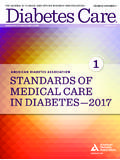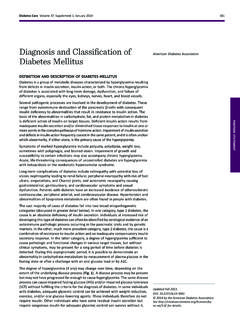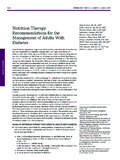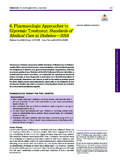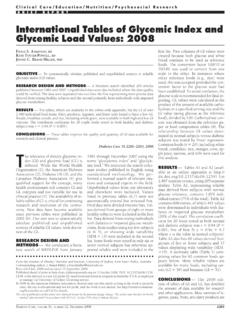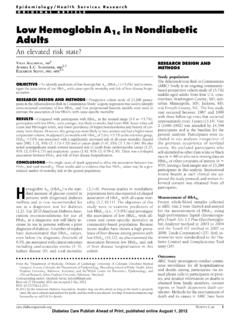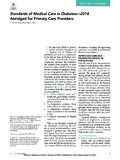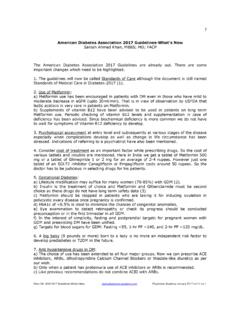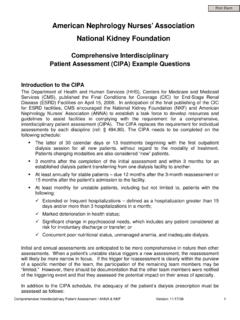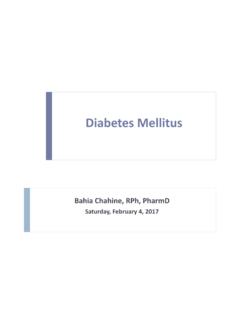Transcription of 9. Cardiovascular Disease and Risk Management: …
1 S86 diabetes Care Volume 41, Supplement 1, January 2018. 9. Cardiovascular Disease and Risk American diabetes Association Management: standards of Medical Care in Diabetesd2018. diabetes Care 2018;41(Suppl. 1):S86 S104 | 9. Cardiovascular Disease AND RISK MANAGEMENT. The American diabetes Association (ADA) standards of Medical Care in diabetes . includes ADA's current clinical practice recommendations and is intended to provide the components of diabetes care, general treatment goals and guidelines, and tools to evaluate quality of care. Members of the ADA Professional Practice Committee, a multidisciplinary expert committee, are responsible for updating the standards of Care annually, or more frequently as warranted.
2 For a detailed description of ADA standards , statements, and reports, as well as the evidence-grading system for ADA's clinical practice recommendations, please refer to the standards of Care Introduction. Readers who wish to comment on the standards of Care are invited to do so at For prevention and management of diabetes complications in children and adolescents, please refer to Section 12 Children and Adolescents.. Atherosclerotic Cardiovascular Disease (ASCVD)dde ned as coronary heart Disease , cerebrovascular Disease , or peripheral arterial Disease presumed to be of atherosclerotic origindis the leading cause of morbidity and mortality for individuals with diabetes and is the largest contributor to the direct and indirect costs of diabetes .
3 Common conditions coexisting with type 2 diabetes ( , hypertension and dyslipidemia) are clear risk factors for ASCVD, and diabetes itself confers in- dependent risk. Numerous studies have shown the ef cacy of controlling individual Cardiovascular risk factors in preventing or slowing ASCVD in people with diabetes . Furthermore, large bene ts are seen when multiple Cardiovascular risk factors are addressed simultaneously. Under the current paradigm of aggressive risk factor modi cation in patients with diabetes , there is evidence that measures of 10-year coronary heart Disease (CHD) risk among adults with diabetes have improved signi cantly over the past decade (1) and that ASCVD morbidity and mortality have decreased (2 4).
4 Therefore, Cardiovascular risk factors should be systematically assessed at least annually in all patients with diabetes . These risk factors include hypertension, dyslipi- demia, smoking, a family history of premature coronary Disease , chronic kidney dis- ease, and the presence of albuminuria. Modi able abnormal risk factors should be Suggested citation: American diabetes Association. treated as described in these guidelines. 9. Cardiovascular Disease and risk management: standards of Medical Care in Diabetesd2018. HYPERTENSION/BLOOD PRESSURE CONTROL diabetes Care 2018;41(Suppl. 1):S86 S104. Hypertension, de ned as a sustained blood pressure $140/90 mmHg, is common 2017 by the American diabetes Association.
5 Among patients with either type 1 or type 2 diabetes . Hypertension is a major risk Readers may use this article as long as the work is properly cited, the use is educational and not factor for both ASCVD and microvascular complications. Moreover, numerous studies for pro t, and the work is not altered. More infor- have shown that antihypertensive therapy reduces ASCVD events, heart failure, and mation is available at microvascular complications. Please refer to the American diabetes Association (ADA) .org/content/license. Cardiovascular Disease and Risk Management S87. position statement diabetes and Hyper- patients who have been educated about c Lower systolic and diastolic blood tension for a detailed review of the epi- added treatment burden, side effects, and pressure targets, such as 130/80.
6 Demiology, diagnosis, and treatment of costs, as discussed below. mmHg, may be appropriate for hypertension (5). Additional studies, such as the Systolic individuals at high risk of cardio- Blood Pressure Intervention Trial (SPRINT). vascular Disease , if they can be Screening and Diagnosis and the Hypertension Optimal Treatment achieved without undue treat- (HOT) trial, also examined effects of inten- Recommendations ment burden. C. sive versus standard control (Table ), c Blood pressure should be measured c In pregnant patients with diabetes though the relevance of their results to at every routine clinical visit.
7 Pa- and preexisting hypertension who people with diabetes is less clear. The tients found to have elevated blood are treated with antihypertensive Action in diabetes and Vascular Disease : pressure ($140/90) should have therapy, blood pressure targets of Preterax and Diamicron MR Controlled blood pressure con rmed using 120 160/80 105 mmHg are sug- gested in the interest of optimiz- Evaluation Blood Pressure (ADVANCE. multiple readings, including meas- ing long-term maternal health BP) trial did not explicitly test blood pres- urments on a separate day, to diag- nose hypertension. B and minimizing impaired fetal sure targets (17); the achieved blood c All hypertensive patients with dia- growth.
8 E pressure in the intervention group was betes should monitor their blood higher than that achieved in the ACCORD. pressure at home. B Randomized clinical trials have demon- BP intensive arm and would be consistent strated unequivocally that treatment of with a target blood pressure of ,140/90. Blood pressure should be measured by a hypertension to blood pressure ,140/90 mmHg. Notably, ACCORD BP and SPRINT. trained individual and should follow the mmHg reduces Cardiovascular events measured blood pressure using auto- guidelines established for the general as well as microvascular complications mated of ce blood pressure measure- population: measurement in the seated (9 15).
9 Therefore, patients with type 1 ments, which yields values that are position, with feet on the oor and arm or type 2 diabetes who have hypertension generally lower than typical of ce blood supported at heart level, after 5 min of should, at a minimum, be treated to blood pressure readings by approximately 5 10 mmHg (18), suggesting that imple- rest. Cuff size should be appropriate for pressure targets of ,140/90 mmHg. In- the upper-arm circumference. Elevated menting the ACCORD BP or SPRINT pro- tensi cation of antihypertensive ther- values should be con rmed on a separate tocols in an outpatient clinic might require apy to target blood pressures lower a systolic blood pressure target higher day.
10 Postural changes in blood pressure than ,140/90 mmHg ( , ,130/80 or and pulse may be evidence of autonomic than ,120 mmHg. ,120/80 mmHg) may be bene cial for neuropathy and therefore require adjust- selected patients with diabetes such as Meta-analyses of Trials ment of blood pressure targets. Orthostatic those with a high risk of Cardiovascular To clarify optimal blood pressure targets blood pressure measurements should be Disease . Such intensive blood pressure in patients with diabetes , meta-analyses checked on initial visit and as indicated. control has been evaluated in large ran- have strati ed clinical trials by mean Home blood pressure self-monitoring domized clinical trials and meta-analyses baseline blood pressure or mean blood and 24-h ambulatory blood pressure of clinical trials.
